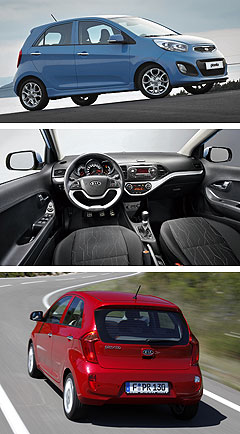Kia to factor VW Up success in Picanto business case
BY HAITHAM RAZAGUI | 9th Oct 2012

At this week’s Sorento SUV launch in Tasmania, KMAu chief operating officer Tony Barlow told GoAuto the company intends to take another look at the business case for importing the Picanto at the end of this year.
However, a meaningful positioning of the Picanto beneath the larger Rio, which starts at $15,290 plus on-road costs as a three-door, will prove challenging and we are unlikely to see the Picanto Down Under before 2014.
“The thing is, can we get the volume because it is not going to be a cheap car?” Mr Barlow said.
The Up is priced from $13,990 plus on-road costs and other segment contenders include the Holden Barina Spark (from $12,490) and Suzuki Alto (from $11,790), while the Mitsubishi Mirage is also set to arrive in January priced from around $13,000.

Mr Barlow said he did not think the car would arrive in Australia next year and said another factor the company “has to assess” was that it could be quite an old model by the time is arrived (it went on sale overseas more than a year ago).
He said if a business case was proved next year, KMAu must then negotiate with the factory and gain endorsement from headquarters in South Korea.
KMAu national marketing manager Steve Watt said it would be tough to price the Picanto attractively while building in sufficient profit margin for KMAu and its dealer network once it has been specified to a level appropriate for the Australian market.
“After you add six airbags, after you add electronic stability control, after you add Bluetooth it starts getting expensive,” he said.
Mr Watt added that it cost about $5 million to establish a new car in the market, which represents a larger chunk of the slimmer margins available on low-priced cars, especially in a segment that is still in its infancy in Australia and not currently growing that quickly.
Volkswagen claims the Up will draw attention to and help define the sub-light segment in Australia, causing volume growth and a larger pie for future contenders to compete for.
Mr Barlow said Kia would “absolutely” be tracking the Up’s progress in this country as part of the Picanto decision-making process and agreed the Up was likely to boost the segment.
Under Euro NCAP crash testing the Picanto scored four stars for safety but in Australia Kia has made a commitment that all new cars will have the maximum five stars.
Mr Barlow was confident the Picanto could score five stars here.
The car tested by Euro NCAP did not have standard side airbags or electronic stability control and some vehicles awarded four stars in Europe have attained five stars under Australasian NCAP criteria.
A close relative of the Picanto is sister company Hyundai’s i10, also not sold in Australia, with one of the reasons given for its exclusion being its inability to attain five ANCAP stars.
Another challenge for KMAu is sourcing the Picanto as it is produced only for right-hand-drive markets in its European factory in Slovakia, which adds logistical and cost impacts.
Mr Watt said that while establishing a steady supply of Picantos from Europe was feasible due to lower volumes caused by the tough economic conditions, overseas demand could suddenly rise at any time if the economy picks up and scupper supply lines to Australia.
Seconding this opinion, Mr Barlow said Kia volumes in Europe were up 25 per cent, with the Picanto and Rio doing particularly well, despite the market as a whole being down around seven per cent.
He did not rule out right-hand-drive production from the South Korean factory if the numbers added up.
As reported, opening up supply from Slovakia could also result in Australia getting the Pro_Cee’d hot hatch and even a wagon derivative of the Europe-focussed small car range.